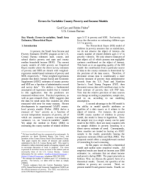Errors-In-Variables County Poverty and Income Models
Errors-In-Variables County Poverty and Income Models
Introduction
At present, the Sm all Area Income and Poverty Estimates (SAIPE) program at the U.S. Census Bureau estimates state, county, and school district poverty and state and county median household income (MHI). The current county models of child poverty are Empirical Bayes models where the direct survey estimates of poverty and MHI are shrunk with weighted-regression model-based estimates of poverty and MHI, respectively. These weighted regressions assume that direct Annual Social and Economic Supplement (ASEC) estimates of county poverty and MHI are a function of administrative record and survey data. We address a fundamental assumption of regression models that is violated in this application: that the predictors are measured without error. Practical experience, as well as past research (Gee, 2001) suggests that the data for small areas like counties are often measured with error for many reasons. Recent developments in experimental SAIPE county-level poverty models (Fisher, 2003) derive a measure of “true” poverty as a function of several independent measures of poverty, all of which are assumed to possess non-negligible variances; i.e., an “errors-in-variables” model. We adapt the method in Fisher (2003) to estimating the county number of related children ages 5-17 in poverty and MHI. For brevity, we focus the discussion on estimating children ages 5-17 in poverty.




